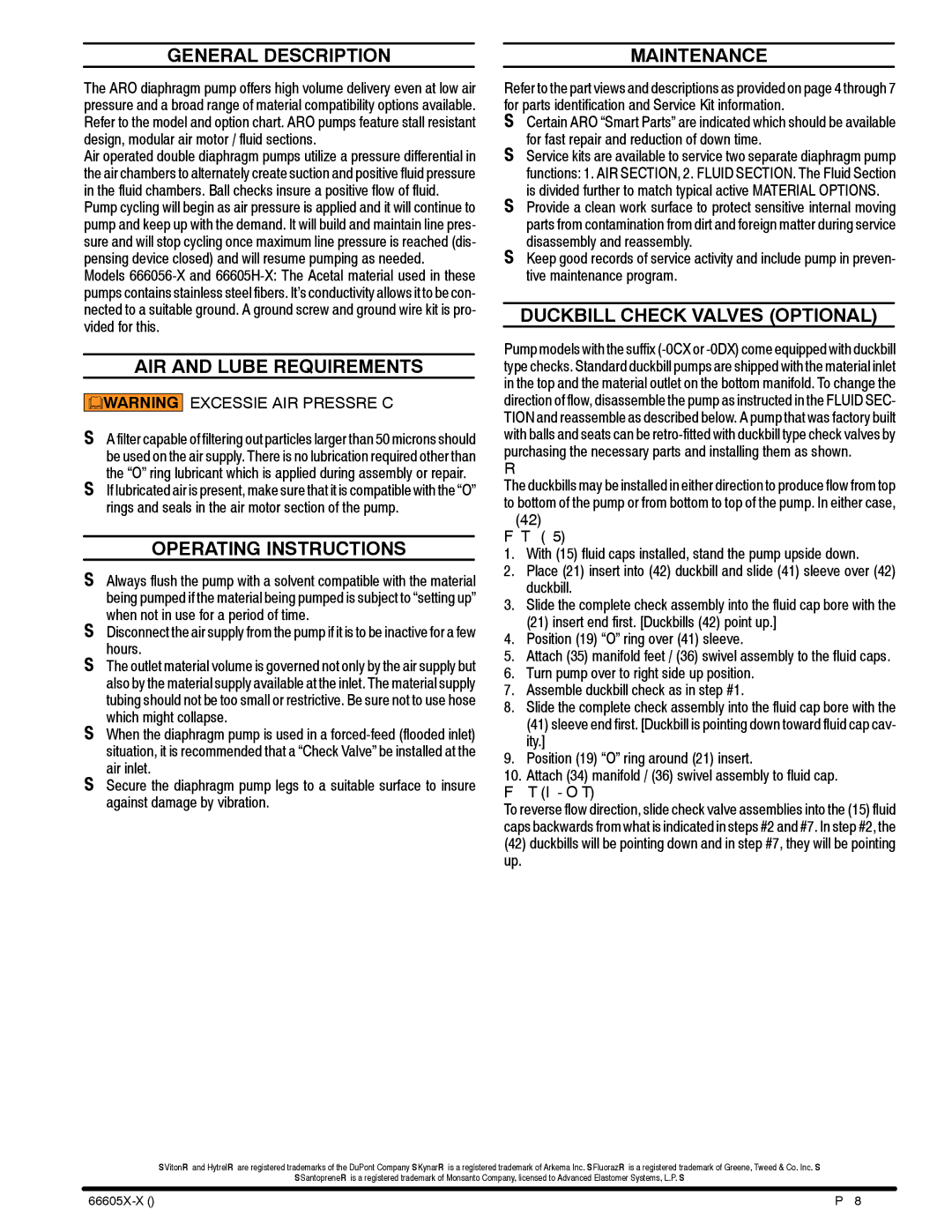
GENERAL DESCRIPTION
The ARO diaphragm pump offers high volume delivery even at low air pressure and a broad range of material compatibility options available. Refer to the model and option chart. ARO pumps feature stall resistant design, modular air motor / fluid sections.
Air operated double diaphragm pumps utilize a pressure differential in the air chambers to alternately create suction and positive fluid pressure in the fluid chambers. Ball checks insure a positive flow of fluid.
Pump cycling will begin as air pressure is applied and it will continue to pump and keep up with the demand. It will build and maintain line pres- sure and will stop cycling once maximum line pressure is reached (dis- pensing device closed) and will resume pumping as needed.
Models
AIR AND LUBE REQUIREMENTS
![]()
![]() WARNING EXCESSIVE AIR PRESSURE. Can cause pump damage, personal injury or property damage.
WARNING EXCESSIVE AIR PRESSURE. Can cause pump damage, personal injury or property damage.
SA filter capable of filtering out particles larger than 50 microns should
be used on the air supply. There is no lubrication required other than the “O” ring lubricant which is applied during assembly or repair.
SIf lubricated air is present, make sure that it is compatible with the “O” rings and seals in the air motor section of the pump.
OPERATING INSTRUCTIONS
SAlways flush the pump with a solvent compatible with the material being pumped if the material being pumped is subject to “setting up”
when not in use for a period of time.
SDisconnect the air supply from the pump if it is to be inactive for a few
hours.
SThe outlet material volume is governed not only by the air supply but also by the material supply available at the inlet. The material supply
tubing should not be too small or restrictive. Be sure not to use hose which might collapse.
SWhen the diaphragm pump is used in a
situation, it is recommended that a “Check Valve” be installed at the air inlet.
SSecure the diaphragm pump legs to a suitable surface to insure against damage by vibration.
MAINTENANCE
Refer to the part views and descriptions as provided on page 4 through 7 for parts identification and Service Kit information.
SCertain ARO “Smart Parts” are indicated which should be available
for fast repair and reduction of down time.
SService kits are available to service two separate diaphragm pump functions: 1. AIR SECTION, 2. FLUID SECTION. The Fluid Section
is divided further to match typical active MATERIAL OPTIONS.
SProvide a clean work surface to protect sensitive internal moving parts from contamination from dirt and foreign matter during service
disassembly and reassembly.
SKeep good records of service activity and include pump in preven- tive maintenance program.
DUCKBILL CHECK VALVES (OPTIONAL)
Pump models with the suffix
Reassembly:
The duckbills may be installed in either direction to produce flow from top to bottom of the pump or from bottom to top of the pump. In either case,
all of the (42) duckbills must point in the same direction. Flow from Top to Bottom: (see page 5)
1.With (15) fluid caps installed, stand the pump upside down.
2.Place (21) insert into (42) duckbill and slide (41) sleeve over (42) duckbill.
3.Slide the complete check assembly into the fluid cap bore with the
(21)insert end first. [Duckbills (42) point up.]
4.Position (19) “O” ring over (41) sleeve.
5.Attach (35) manifold feet / (36) swivel assembly to the fluid caps.
6.Turn pump over to right side up position.
7.Assemble duckbill check as in step #1.
8.Slide the complete check assembly into the fluid cap bore with the
(41)sleeve end first. [Duckbill is pointing down toward fluid cap cav-
ity.]
9.Position (19) “O” ring around (21) insert.
10.Attach (34) manifold / (36) swivel assembly to fluid cap.
Flow from Bottom to Top: (Inlet Bottom - Outlet Top)
To reverse flow direction, slide check valve assemblies into the (15) fluid caps backwards from what is indicated in steps #2 and #7. In step #2, the
(42)duckbills will be pointing down and in step #7, they will be pointing
up.
S VitonR and HytrelR are registered trademarks of the DuPont Company S KynarR is a registered trademark of Arkema Inc. S FluorazR is a registered trademark of Greene, Tweed & Co. Inc. S
S SantopreneR is a registered trademark of Monsanto Company, licensed to Advanced Elastomer Systems, L.P. S
Page 3 of 8 |
